Centre de Recherche en Automatique de Nancy
2 avenue de la forêt de Haye, TSA 60604, 54518 Vandœuvre cedex
Participation à la rédaction d'ouvrages
Navigation Rapide
|
Orjuela R., Ichalal D., Marx B., Maquin D., Ragot J. "Polytopic models for observer and fault tolerant control designs". In New Trends on Observer based Controller Design and their Applications, Volume I. Observer-Based Control Design, chapter 8, Emerging Methodologies and Applications in Modelling, Identification and Control book series, Boubaker O., Zhu Q., Mahmoud M.S., Ragot J., Karimi H.R. and Davila J. eds, ISBN : 978-01281703-8-0, Academic Press, March 2019 |
|
|---|---|
 |
New Trends in Observer-Based Control, Volume: 1 Design presents a clear and concise introduction to latest advances in observer-based control design. This book gives a comprehensive tutorial on the new trends in design of observer-based controllers for which the separation principle is well established. In addition, since the theoretical developments remain more advanced than the engineering applications, more experimental results are still expected. It covers a wide range of applications. The book contains worked examples which make it ideal for advanced courses as well as for researchers starting to work in the field. This book is also particularly suitable for engineers wishing to enter the field quickly and efficiently.
|
|
Srinivasarengan K., Aubrun C., Maquin D., Ragot J., "A survey of modeling and fault detection and diagnosis in building energy management systems". In Selected Issues of Control Engineering and Economics, Izabella Cech ed., pp. 1-14, ISBN 978-83-63349-10-3, Panstwowa Wyzsza Szkola Zawodowa w Glogowie, 2015. |
|
|---|---|
 |
|
|
Ichalal D., Marx B., Maquin D., Ragot J., "Observer design and fault tolerant control of Takagi-Sugeno nonlinear systems with unmeasurable premise variables". In Fault Diagnosis in Robotic and Industrial Systems, Gerasimos Rigatos ed., chapter 5, 21 p., ISBN 978-14610987-4-4, iConceptPress, 2012. |
|
|---|---|
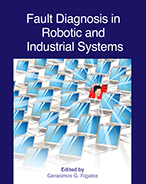 |
|
|
He X., Mourot G., Maquin D., Ragot J., Beauseroy P., Smolarz A., Grall-Maës E., "Multitask Learning for the Diagnosis of Machine Fleet". In Supervision and safety of complex systems, Nada Matta, Yves Vandenboomgaerde, Jean Arlat eds., chapter 7, 26 p., ISBN 978-1-84821-413-2, Wiley-ISTE, Paris, 2012. |
|
|---|---|
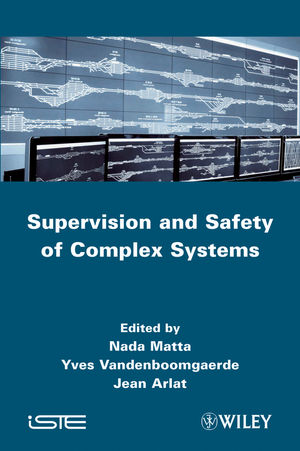 |
|
|
He X., Mourot G., Maquin D., Ragot J., Beauseroy P., Smolarz A., Grall-Maës E., "Apprentissage multi-tâches pour le diagnostic d'un parc de machines". In Supervision, surveillance et sûreté de fonctionnement des grands systèmes, Nada Matta, Yves Vandenboomgaerde, Jean Arlat eds., chapitre 7, 26 p., ISBN 978-2-7462-3840-4, Traité Information, Commande, Communication, IC2, Hermès Science Publications, Paris, 2012. |
|
|---|---|
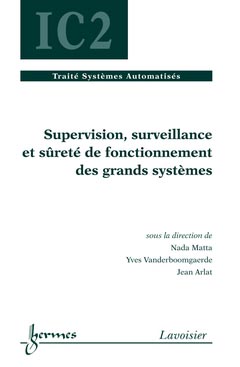 |
|
|
Maquin D., Marx B., Ragot J., "Surveillance et diagnostic". In Automatique : du cahier des charges à la réalisation de systèmes, René Husson ed., chapitre 16, 51 p., ISBN 978-2-10-050397-1, Sciences Sup, Dunod, Paris, 2007. |
|
|---|---|
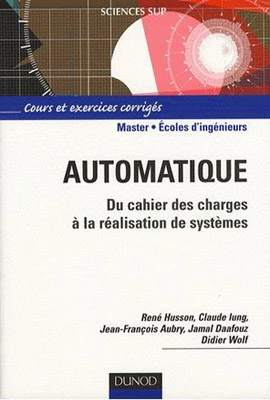 |
Cet ouvrage, unique en son genre, réalise une synthèse générale sur l'automatique. Les auteurs utilisent des applications afin de faciliter l'appréhension des concepts abstraits et des difficultés de ce domaine foisonnant, en perpétuelle évolution technique. Le lecteur est ainsi guidé à travers les outils mis à la disposition des ingénieurs pour résoudre des problèmes industriels de plus en plus complexes. Tous les champs de l'automatique y sont ainsi envisagés : modèles, commande, identification, traitement du signal, surveillance, sûreté de fonctionnement... Outre les aspects théoriques nécessaires, l'accent y est mis sur le concret : outils informatiques, normes, sûreté, applications technologiques et scientifiques. Le cours est illustré par de nombreux exemples et des exercices corrigés facilitent la compréhension des concepts. Une "boîte à outils", placée en fin d'ouvrage, prend en compte la diversité des parcours de formation et permettra à l'étudiant de se remettre en mémoire quelques éléments de calcul matriciel, d'algèbre de Boole ou de théorie des graphes. Principalement destiné aux élèves en école d'ingénieurs et aux étudiants de l'enseignement supérieur en transition vers les carrières d'ingénieurs, la lecture de cet ouvrage de référence sera également profitable aux candidats à l'agrégation de Physique Appliquée ou de Génie Électrique.
|
|
Maquin D., Ragot J., "Validation de données à base de modèles". In Supervision des procédés complexes, Sylviane Gentil ed., chapitre 5, 38 p., ISBN 978-2-7462-1510-8, Traité Information, Commande, Communication, IC2, Hermès Science Publications, Paris, 2007. Ragot J., Maquin D., Gentil S., "Diagnostic fondé sur un modèle quantitatif". In Supervision des procédés complexes, Sylviane Gentil ed., chapitre 5, 38 p., ISBN 978-2-7462-1510-8, Traité Information, Commande, Communication, IC2, Hermès Science Publications, Paris, 2007. |
|
|---|---|
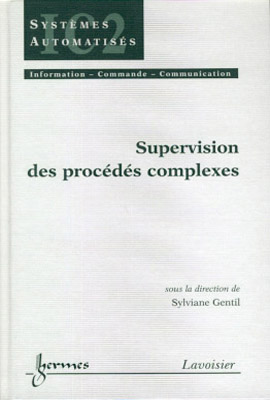 |
Superviser un procédé complexe suppose que l'on s'intéresse à son fonctionnement global, dans ses divers modes de marche, y compris les modes défaillants. Il faut donc surveiller l'ensemble des variables, identifier l'état du procédé, anticiper son évolution et agir pour garantir la sûreté et la disponibilité de l'installation, voire si c'est possible pour maintenir la production. Cet ouvrage s'adresse aux étudiants, industriels et chercheurs désirant avoir un panorama des outils récents de supervision avancée. On y trouvera des méthodes fondées sur l'analyse de l'évolution des variables (traitement du signal pour le diagnostic, analyse de tendances qualitatives, reconnaissance de formes et classification) et des méthodes fondées sur des modèles mathématiques du procédé (validation de données, diagnostic, raisonnement causal). Les systèmes hybrides y sont abordés ainsi que la commande tolérante aux défauts. Des exemples pédagogiques aussi bien que des applications industrielles servent à illustrer les différents outils.
|
|
Maquin D., Ragot J., "Surveillance des réseaux de distribution d'eau potable". In Automatique et statistiques pour le diagnostic, Bernard Dubuisson ed., chapitre 5, 30 p., ISBN 2-7462-0248-4, Traité Information, Commande, Communication, IC2, Hermès Science Publications, Paris, 2001. Ragot J., Maquin D., "Génération d'indicateurs de défauts à base d'observateurs". In Automatique et statistiques pour le diagnostic, Bernard Dubuisson ed., chapitre 5, 30 p., ISBN 2-7462-0248-4, Traité Information, Commande, Communication, IC2, Hermès Science Publications, Paris, 2001. |
|
|---|---|
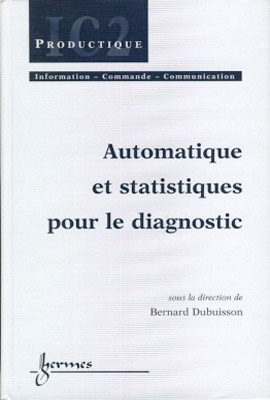 |
Automatique et statistiques pour le diagnostic
|
|
Ragot J., Maquin D., "Séries et fonctions orthogonales". In Algèbre et analyse pour l'automatique, Jean-Pierre Richard ed., chapitre 4, 30 p., ISBN 2-7462-0198-4, Traité Information, Commande, Communication, IC2, Hermès Science Publications, Paris, 2001. |
|
|---|---|
 |
Automatique et statistiques pour le diagnostic
|
|
Ragot J., Maquin D., Kratz F., "Observability and redundancy decomposition. Application to diagnosis". In Issues of fault diagnosis for dynamic systems. Chapter 3, Patton R.J., Frank P.M., Clark R.N. eds., ISBN 3-540-19968-3, Springer Verlag, 2000. |
|
|---|---|
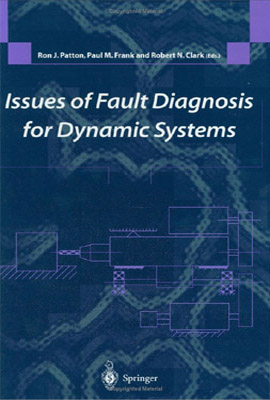 |
There is an increasing demand for dynamic systems to become safer, more reliable and more economical in operation. This requirement extends beyond the normally accepted safety-critical systems e.g., nuclear reactors, aircraft and many chemical processes, to systems such as autonomous vehicles and some process control systems where the system availability is vital. The field of fault diagnosis for dynamic systems (including fault detection and isolation) has become an important topic of research. Many applications of qualitative and quantitative modelling, statistical processing and neural networks are now being planned and developed in complex engineering systems. Issues of Fault Diagnosis for Dynamic Systems has been prepared by experts in fault detection and isolation (FDI) and fault diagnosis with wide ranging experience.
|
|
Maquin D., Ragot J., "Diagnostic des systèmes linéaires", Collection Pédagogique d'Automatique, 143 p., ISBN 2-7462-0133-X, Hermès Science Publications, Paris, 2000. |
|
|---|---|
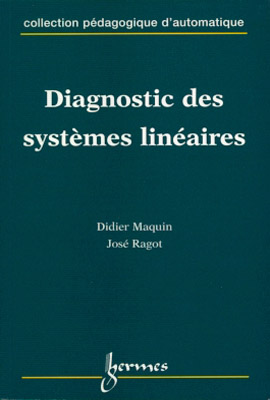 |
Les méthodes de détection de défauts basées sur l'utilisation de modèles, développées depuis le début des années soixante-dix, ont atteint aujourd'hui un degré de maturité suffisant pour constituer un corpus d'enseignement. Cet ouvrage permet une première approche des méthodes les plus classiques utilisées pour la détection-localisation de défauts sur un processus(défauts de capteurs, d'actionneurs, voire du processus lui-même). Diagnostic des systèmes linéaires s'adresse aux étudiants - de niveau maîtrise, DEA, DESS ou troisième année de formation d'ingénieur - souhaitant acquérir rapidement une première compétence dans ces méthodes ainsi qu'aux enseignants désirant mettre en place une formation dans ce domaine. Il intéresse aussi les ingénieurs chargés du suivi de production de processus continus (chimie, pétrochimie, réseaux de transport de fluide, minéralurgie...).
|
|
Maquin D., Ragot J., "Process flow rates reconciliation and data analysis". In The contribution of advanced technologies. Monitoring of water quality, Colin F., Quevauviller P. eds., ISBN 0-08-043340-5, Elsevier 1998. |
|
|---|---|
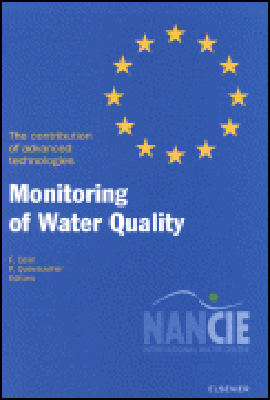 |
Water can be considered as one of the basic elements supporting life and the natural environment, a primary component for industry, a consumer item for humans and animals and a vector for domestic and industrial pollution. Various European Directives already provide a framework for the control of aquatic substances, the quality of bathing, surface and drinking water and effluent control. Such regulatory measures are closely related to analytical measurements. In order to comply with these regulations on a permanent basis, treatment plants and distribution companies, as well as water users and polluters, need to implement automated measuring techniques, such as sensors and other analytical tools in continuous or sequential mode to obtain suitable alarm systems and facilitate the management of water resources and decision making processes. This approach is in continuous evolution within the European Union. In view of the consequences of wrong measurements, it is vital that reliable quality control systems be achieved and maintained. At present, only a small range of analytical parameters can be measured automatically, it is therefore necessary to develop and validate new methods to extend the list of parameters. The development of new methodologies requires that the most recent know-how in fields such as optics, electrochemistry, biochemistry, chemometrics and others be shared by experts. In order to identify possible actions to be undertaken in the field of standards, measurements and testing for monitoring water quality, the Standards Measurements and Testing (SMT) Programme of the European Union, organised a European workshop that was held in Nancy 29-31 May 1997. This workshop bought together researchers and industrial users with the aim to make an overview of the present state-of-the-art, to consider possible improvements in existing techniques and the need and possibilities of developing new advanced technologies. |
|
Ragot J., Darouach M., Maquin D., Bloch G., "Validation de données et diagnostic". Traité des nouvelles technologies, série diagnostic et maintenance, 432 p., ISBN 2-86601-238-0, Hermès Science Publications, 1990. |
|
|---|---|
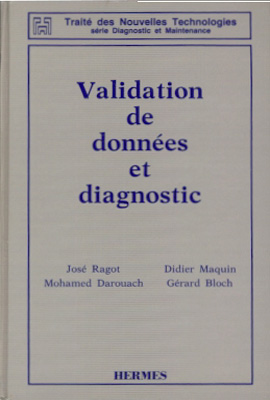 |
Cet ouvrage traite du problème de validation de mesures de systèmes linéaires et non linéaires décrits par des modèles exacts. Partant de la réconciliation de données pour un système décrit par des équations linéaires, le problème est ensuite progressivement complexifié (observations partielles, prise en compte de variation de stocks,...). Les méthodes de résolution sont exposées avec le souci constant de leur facilité de mise en oeuvre. Validation de données et diagnostic s'adresse aux ingénieurs chargés du suivi de production et de la maintenance des procédés continus (secteurs chimiques, pétrochimiques, minéralurgiques, ...), aux étudiants en automatique (Maîtrise, DEA, Ecoles d'ingénieurs) ainsi qu'aux chercheurs concernés par les problèmes de diagnostic en général.
|
|
Ragot J., Darouach M., Maquin D., "Mass-balance equilibration". Outline of contribution to the NATO Advanced Study Institute Ankara, Turkey, August, 21-30, 1984. In Mineral Processing Design (Yarar B., Dogan Z.M. eds), chap. 8, pp. 221-249, NATO ASI series E: Applied Sciences, no 122, ISBN 9-02473-472-X, Martinus Nijhoff Publishers, Dordrecht, 1987. |
|
|---|---|
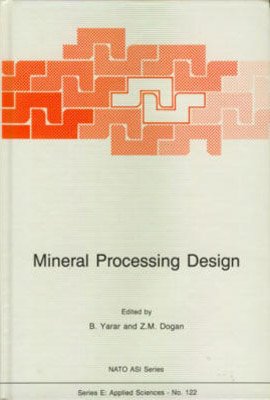 |
Mineral Processing Design
|
Envoyez vos suggestions à Didier.Maquin[at]univ-lorraine.fr
Dernière modification : 30 septembre 2024

